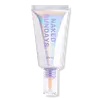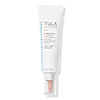Naked Sundays Beautyscreen Peptide Foundation Tint SPF 50 Versus Tula Skincare Radiant Skin Brightening Serum Skin Tint Sunscreen SPF 30
What's inside
What's inside
 Key Ingredients
Key Ingredients

 Benefits
Benefits

 Concerns
Concerns

 Ingredients Side-by-side
Ingredients Side-by-side

Zinc Oxide 12%
Cosmetic ColorantWater
Skin ConditioningC12-15 Alkyl Benzoate
AntimicrobialButyloctyl Salicylate
Skin ConditioningIsododecane
EmollientLauryl PEG-8 Dimethicone
Iron Oxides
CI 77492
Cosmetic ColorantPropanediol
SolventCI 77491
Cosmetic ColorantCaprylyl Methicone
Skin ConditioningDimethicone
EmollientNiacinamide
SmoothingOctyldodecyl Neopentanoate
EmollientPolymethylsilsesquioxane
Trilaureth-4 Phosphate
EmulsifyingCI 77499
Cosmetic ColorantDimethiconol
EmollientLauryl PEG-10 Tris(Trimethylsiloxy)Silylethyl Dimethicone
EmulsifyingSodium Chloride
MaskingPhenoxyethanol
PreservativeBisabolol
MaskingCaprylyl Glycol
EmollientAllantoin
Skin ConditioningPolyglyceryl-4 Diisostearate/Polyhydroxystearate/Sebacate
EmulsifyingHydrogenated Lecithin
EmulsifyingEthylhexylglycerin
Skin ConditioningHexylene Glycol
EmulsifyingPEG-10
HumectantTetrasodium Glutamate Diacetate
Palmitoyl Pentapeptide-4
Skin ConditioningSqualane
EmollientSodium Hydroxide
BufferingTitanium Dioxide
Cosmetic ColorantPolyglutamic Acid
Skin ConditioningAluminum Hydroxide
EmollientZinc Oxide 12%, Water, C12-15 Alkyl Benzoate, Butyloctyl Salicylate, Isododecane, Lauryl PEG-8 Dimethicone, Iron Oxides, CI 77492, Propanediol, CI 77491, Caprylyl Methicone, Dimethicone, Niacinamide, Octyldodecyl Neopentanoate, Polymethylsilsesquioxane, Trilaureth-4 Phosphate, CI 77499, Dimethiconol, Lauryl PEG-10 Tris(Trimethylsiloxy)Silylethyl Dimethicone, Sodium Chloride, Phenoxyethanol, Bisabolol, Caprylyl Glycol, Allantoin, Polyglyceryl-4 Diisostearate/Polyhydroxystearate/Sebacate, Hydrogenated Lecithin, Ethylhexylglycerin, Hexylene Glycol, PEG-10, Tetrasodium Glutamate Diacetate, Palmitoyl Pentapeptide-4, Squalane, Sodium Hydroxide, Titanium Dioxide, Polyglutamic Acid, Aluminum Hydroxide
Butyl Methoxydibenzoylmethane 3%
UV AbsorberEthylhexyl Salicylate 5%
UV AbsorberWater
Skin ConditioningC9-12 Alkane
SolventButyloctyl Salicylate
Skin ConditioningCaprylic/Capric Triglyceride
MaskingEthylhexyl Palmitate
EmollientTriethylhexanoin
MaskingPolyglyceryl-6 Polyhydroxystearate
EmulsifyingPolyglyceryl-6 Polyricinoleate
EmulsifyingIsododecane
EmollientSilica
AbrasiveButylene Glycol
HumectantDisteardimonium Hectorite
StabilisingTrimethylsiloxysilicate
EmollientVp/Eicosene Copolymer
Glycerin
HumectantArgania Spinosa Kernel Oil
EmollientTocopheryl Acetate
AntioxidantLactococcus Ferment Lysate
Skin ConditioningLactobacillus Ferment
Skin ConditioningLactobacillus
Skin ConditioningKappaphycus Alvarezii Extract
Skin ConditioningTetrahexyldecyl Ascorbate
AntioxidantNiacinamide
SmoothingSodium Hyaluronate
HumectantCeramide NP
Skin ConditioningPongamia Glabra Seed Oil
Skin ConditioningDunaliella Salina Extract
Skin ConditioningHaematococcus Pluvialis Extract
AntioxidantAcacia Seyal Gum Extract
HumectantCaesalpinia Spinosa Fruit Extract
Skin ProtectingAlpha-Glucan Oligosaccharide
CleansingBisabolol
MaskingBeta Vulgaris Root Extract
Skin ConditioningCystoseira Tamariscifolia Extract
Skin ConditioningInulin
Skin ConditioningLactic Acid
BufferingPolymnia Sonchifolia Root Juice
Skin ConditioningCurcuma Longa Root Extract
MaskingVp/Hexadecene Copolymer
Octyldodecyl Neopentanoate
EmollientSodium Chloride
MaskingMagnesium Sulfate
Boron Nitride
AbsorbentSorbitan Oleate
EmulsifyingPolyglycerin-6
HumectantOctyldodecanol
EmollientSafflower Oil/Palm Oil Aminopropanediol Esters
Skin ConditioningMica
Cosmetic ColorantHydrogenated Lecithin
EmulsifyingAscorbyl Palmitate
AntioxidantPentaerythrityl Tetra-Di-T-Butyl Hydroxyhydrocinnamate
AntioxidantDimethicone
EmollientTocopherol
AntioxidantMaltodextrin
AbsorbentEthylhexylglycerin
Skin ConditioningAluminum Hydroxide
EmollientCitric Acid
Buffering1,2-Hexanediol
Skin ConditioningCaprylyl Glycol
EmollientPhenoxyethanol
PreservativeSodium Benzoate
MaskingPotassium Sorbate
PreservativeCI 77891
Cosmetic ColorantCI 77492
Cosmetic ColorantCI 77491
Cosmetic ColorantCI 77499
Cosmetic ColorantButyl Methoxydibenzoylmethane 3%, Ethylhexyl Salicylate 5%, Water, C9-12 Alkane, Butyloctyl Salicylate, Caprylic/Capric Triglyceride, Ethylhexyl Palmitate, Triethylhexanoin, Polyglyceryl-6 Polyhydroxystearate, Polyglyceryl-6 Polyricinoleate, Isododecane, Silica, Butylene Glycol, Disteardimonium Hectorite, Trimethylsiloxysilicate, Vp/Eicosene Copolymer, Glycerin, Argania Spinosa Kernel Oil, Tocopheryl Acetate, Lactococcus Ferment Lysate, Lactobacillus Ferment, Lactobacillus, Kappaphycus Alvarezii Extract, Tetrahexyldecyl Ascorbate, Niacinamide, Sodium Hyaluronate, Ceramide NP, Pongamia Glabra Seed Oil, Dunaliella Salina Extract, Haematococcus Pluvialis Extract, Acacia Seyal Gum Extract, Caesalpinia Spinosa Fruit Extract, Alpha-Glucan Oligosaccharide, Bisabolol, Beta Vulgaris Root Extract, Cystoseira Tamariscifolia Extract, Inulin, Lactic Acid, Polymnia Sonchifolia Root Juice, Curcuma Longa Root Extract, Vp/Hexadecene Copolymer, Octyldodecyl Neopentanoate, Sodium Chloride, Magnesium Sulfate, Boron Nitride, Sorbitan Oleate, Polyglycerin-6, Octyldodecanol, Safflower Oil/Palm Oil Aminopropanediol Esters, Mica, Hydrogenated Lecithin, Ascorbyl Palmitate, Pentaerythrityl Tetra-Di-T-Butyl Hydroxyhydrocinnamate, Dimethicone, Tocopherol, Maltodextrin, Ethylhexylglycerin, Aluminum Hydroxide, Citric Acid, 1,2-Hexanediol, Caprylyl Glycol, Phenoxyethanol, Sodium Benzoate, Potassium Sorbate, CI 77891, CI 77492, CI 77491, CI 77499
 Reviews
Reviews

Ingredients Explained
These ingredients are found in both products.
Ingredients higher up in an ingredient list are typically present in a larger amount.
Aluminum Hydroxide is a form of aluminum. It can be naturally found in nature as the mineral gibbsite. In cosmetics, Aluminum Hydroxide is used as a colorant, pH adjuster, and absorbent.
As a colorant, Aluminum Hydroxide may add opacity, or reduce the transparency. Aluminum hydroxide is contains both basic and acidic properties.
According to manufacturers, this ingredient is an emollient and humectant. This means it helps hydrate the skin.
In medicine, this ingredient is used to help relieve heartburn and help heal ulcers.
There is currently no credible scientific evidence linking aluminum hydroxide in cosmetics to increased cancer risk.
Major health organizations allow the use of aluminum hydroxide in personal care products and have not flagged it as a carcinogenic risk at typical usage levels.
Learn more about Aluminum HydroxideBisabolol is famous for its skin soothing properties. It does this by blocking inflammatory signals, helping to reduce your body's reaction to irritation.
This ingredient also interferes with the process of hyperpigmentation. This can help with reducing dark spots and uneven tone.
Bisabolol is an antioxidant. Antioxidants help fight free-radicals. Free-radicals are molecules that may damage your skin cells. By fighting these free-radicals, Bisabolol may slow down signs of aging.
Studies have shown Bisabolol to have antimicrobial properties and may be a fungicide. These properties help preserve a product's shelf life.
All these properties makes bisabolol a great skin barrier helper ingredient.
Bisabolol also helps the absorption of other ingredients.
Note: Synthetic Bisabolol has been shown to be less effective.
Learn more about BisabololButyloctyl Salicylate is a chemical UV filter structurally similar to octisalate. It is a photostabilizer, SPF booster, emollient and solvent. This ingredient helps evenly spread out ingredients.
According to a manufacturer, it is suitable for pairing with micro Titanium Dioxide, Zinc Oxide, and pigments.
Photostabilizers help stabilize UV-filters and prevents them from degrading quickly.
Learn more about Butyloctyl SalicylateCaprylyl Glycol is a humectant and emollient, meaning it attracts and preserves moisture.
It is a common ingredient in many products, especially those designed to hydrate skin. The primary benefits are retaining moisture, skin softening, and promoting a healthy skin barrier.
Though Caprylyl Glycol is an alcohol derived from fatty acids, it is not the kind that can dry out skin.
This ingredient is also used as a preservative to extend the life of products. It has slight antimicrobial properties.
Learn more about Caprylyl GlycolCi 77491 is also hydrated iron III oxide. It's sole purpose is to give a red/pink hue to products.
Iron III oxides are classified as inorganic chemicals for coloring.
Synthetically created Ci 77491 is considered safer than those naturally found. This is because the synthetically created version may contain less impurities. Iron oxides are generally non-toxic and non-allergenic.
Learn more about CI 77491Ci 77492 is also hydrated iron III oxide. It's sole purpose is to give a yellow hue to products.
Iron III oxides are classified as inorganic chemicals for coloring.
Synthetically created Ci 77492 is considered safer than those naturally found. This is because the synthetically created version may contain less impurities. Iron oxides are generally non-toxic and non-allergenic.
Learn more about CI 77492Ci 77499 is also hydrated iron III oxide. It is created from mixing red and black iron oxides. This helps give shades of darkness to a product.
Iron III oxides are classified as inorganic chemicals for coloring.
Dimethicone is a type of synthetic silicone created from natural materials such as quartz.
What it does:
Dimethicone comes in different viscosities:
Depending on the viscosity, dimethicone has different properties.
Ingredients lists don't always show which type is used, so we recommend reaching out to the brand if you have questions about the viscosity.
This ingredient is unlikely to cause irritation because it does not get absorbed into skin. However, people with silicone allergies should be careful about using this ingredient.
Note: Dimethicone may contribute to pilling. This is because it is not oil or water soluble, so pilling may occur when layered with products. When mixed with heavy oils in a formula, the outcome is also quite greasy.
Learn more about DimethiconeEthylhexylglycerin (we can't pronounce this either) is commonly used as a preservative and skin softener. It is derived from glyceryl.
You might see Ethylhexylglycerin often paired with other preservatives such as phenoxyethanol. Ethylhexylglycerin has been found to increase the effectiveness of these other preservatives.
Hydrogenated Lecithin is created from the hydrogenation of lecithin (a group of phospholipids). Hydrogenation is a chemical reaction between hydrogen and another element.
This ingredient is an emollient and emulsifier. As an emollient, it helps soften skin by trapping moisture within. As an emulsifier, it prevents oil and water ingredients from separating.
Isododecane is a fragrance, emollient, and solvent.
As an emollient, it helps your skin stay soft and hydrated. Emollients help trap moisture into your skin.
Isododecane's role as a solvent makes it a great texture enhancer. It spreads smoothly on skin and does not leave a sticky feeling behind. Isododecane also helps prevent color transfer in makeup products.
Isododecane is not absorbed into skin.
Learn more about IsododecaneNiacinamide is a multitasking form of vitamin B3 that strengthens the skin barrier, reduces pores and dark spots, regulates oil, and improves signs of aging.
And the best part? It's gentle and well-tolerated by most skin types, including sensitive and reactive skin.
You might have heard of "niacin flush", or the reddening of skin that causes itchiness. Niacinamide has not been found to cause this.
In very rare cases, some individuals may not be able to tolerate niacinamide at all or experience an allergic reaction to it.
If you are experiencing flaking, irritation, and dryness with this ingredient, be sure to double check all your products as this ingredient can be found in all categories of skincare.
When incorporating niacinamide into your routine, look out for concentration amounts. Typically, 5% niacinamide provides benefits such as fading dark spots. However, if you have sensitive skin, it is better to begin with a smaller concentration.
When you apply niacinamide to your skin, your body converts it into nicotinamide adenine dinucleotide (NAD). NAD is an essential coenzyme that is already found in your cells as "fuel" and powers countless biological processes.
In your skin, NAD helps repair cell damage, produce new healthy cells, support collagen production, strengthen the skin barrier, and fight environmental stressors (like UV and pollution).
Our natural NAD levels start to decline with age, leading to slower skin repair, visible aging, and a weaker skin barrier. By providing your skin niacinamide, you're recharging your skin's NAD levels. This leads to stronger, healthier, and younger looking skin.
Another name for vitamin B3 is nicotinamide. This vitamin is water-soluble and our bodies don't store it. We obtain Vitamin B3 from either food or skincare. Meat, fish, wheat, yeast, and leafy greens contain vitamin B3.
The type of niacinamide used in skincare is synthetically created.
Learn more about NiacinamideWe don't have a description for Octyldodecyl Neopentanoate yet.
Phenoxyethanol is a preservative that has germicide, antimicrobial, and aromatic properties. Studies show that phenoxyethanol can prevent microbial growth. By itself, it has a scent that is similar to that of a rose.
It's often used in formulations along with Caprylyl Glycol to preserve the shelf life of products.
Chances are, you eat sodium chloride every day. Sodium Chloride is also known as table salt.
This ingredient has many purposes in skincare: thickener, emulsifier, and exfoliator.
You'll most likely find this ingredient in cleansers where it is used to create a gel-like texture. As an emulsifier, it also prevents ingredients from separating.
There is much debate on whether this ingredient is comedogenic. The short answer - comedogenic ratings don't tell the whole story. Learn more about comegodenic ratings here.
The concensus about this ingredient causing acne seems to be divided. Research is needed to understand if this ingredient does cause acne.
Scrubs may use salt as the primary exfoliating ingredient.
Learn more about Sodium ChlorideWater. It's the most common cosmetic ingredient of all. You'll usually see it at the top of ingredient lists, meaning that it makes up the largest part of the product.
So why is it so popular? Water most often acts as a solvent - this means that it helps dissolve other ingredients into the formulation.
You'll also recognize water as that liquid we all need to stay alive. If you see this, drink a glass of water. Stay hydrated!
Learn more about Water